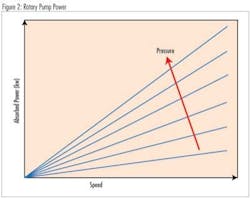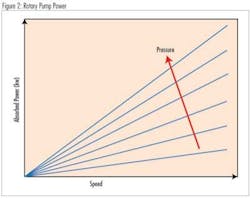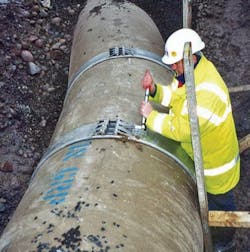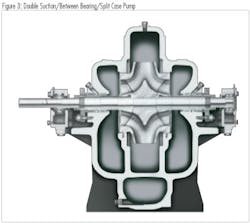Back to Basics: Pump Types - End Suction Vs. Double Suction
By Allan R. Budris
There are often multiple pump types (Table 1) that can be selected for the same water application, with each pump type having its own strengths and weaknesses. This column tries to help guide the reader in the selection of the best pump type that will yield the greatest reliability and lowest life cycle cost for a specific application.
End Suction Water Pumps
An end suction water pump would probably have the lowest initial cost for most applications, with reasonable efficiency. However, these pumps do not follow any standards, especially with regard to bearing life, shaft seal housings and dimensional interchangeability. They are also typically constructed with the lowest cost materials, such as cast iron casings with bronze or brass impellers. The impellers are typically of closed construction, without replaceable casing or impeller wearing rings. Further, there is typically more deviation from published performance, such as efficiency, for this pump type.
For non-critical, intermittent service applications these pumps may be the best choice. However, for critical applications, requiring long operating life, the cost of maintenance and down time may far exceed any initial cost savings.
End Suction ANSI/ASME B-73 Pumps
Chemical pumps (figure 1), which can handle corrosive, and/or toxic liquids and slurries, are available in a variety of configurations and materials. Pumps used in this industry are different from those used in other industries, primarily in the materials of construction and the many mechanical shaft seal configurations available. These pumps must also meet the American Society of Mechanical Engineers ANSI B73 standards, which require dimensional interchangeability, minimum bearing life, and many other quality specifications. The minimum casing material is ductile iron, with stainless steel being quite common. Typical construction is an adjustable open impeller, which is also good at handling entrained air.
Because of these upgraded features, reliability focused users will typically select an ANSI/ASME B-73 pump over a lower cost water pump for other critical applications, including water services.
End Suction Paper Stock / Process Pump
Even though this overhung, frame mounted pump type (see figure 2) was primarily designed to handle paper stock (up to 6%), it is also used to handle higher capacity chemical and critical water pump applications. These pumps typically have adjustable open impellers with replaceable wear plates to handle abrasive paper stock and entrained air. Construction is normally 316 SST or duplex SST.
This end suction pump choice is also a candidate for water service flow rates above about 3,000 to 5,000 gpm, even though many pump users would probably be looking at Double Suction, between bearing, split case pumps in this flow range.
Double Suction, Between Bearing, Split Case Pumps
Double suction, between bearing, split case pumps (see figure 3) are the second most popular centrifugal pump configuration, second only to the more common end suction, radial split design.
The principal reasons for the popularity of this between-bearing configuration include:
1. The rotor can be removed by just taking off the upper casing half, without disturbing the suction or discharge piping, or moving the motor
2. Less shaft deflection due to the between-bearing design.
3. Lower NPSH requirement due to the fact that each impeller eye only handles one half of the total pump flow rate.
4. Virtually no axial hydraulic thrust, due to the back-to-back / double suction impeller design.
5. Higher efficiency because power is not lost to balance the hydraulic thrust.
6. Relatively high allowable nozzle loads due to the rigidity of the lower portion of the casing.
Although split case, between-bearing models are quite popular, and have many advantages as listed above, the pumps are not without some drawbacks.
1. Due to the large flanges required for the split casing sealing joint, these pumps are normally heavier and cost more than comparable end suction pumps, especially in higher alloy and higher pressure applications.
2. While double-suction impeller pumps have lower NPSHr values then comparable end suction pumps, the through-shaft reduces the impeller eye area. This requires an increase in the suction eye diameter (higher eye tip speed and suction energy). Also, in order to keep the shaft bearing span to a minimum for critical speed purposes, the compressed inlet passages result in tight turns for the liquid entering the impeller eye. The gating Suction Energy and required NPSH margins tend to increase as a consequence. This phenomenon has caused field problems with high and very high suction energy pumps, when operating at low NPSH margins and/or when operating in suction recirculation (See October 2007 column). It should be noted that some of the newer split case pumps do have improved casing inlet designs (less inlet turbulence), which allows them to approach the higher suction energy performance (gating values) of end suction pumps.
3. Double-suction pumps are more sensitive to the orientation and geometry (radius) of elbows in front of the pump inlet (see April 2009 column). Suction elbows should be perpendicular to the plan view of the shaft. This reduces the tendency of unequal flow quantities reaching the two impeller eyes. Suction elbows in the plan of the shaft can cause uneven flow patterns which can upset the axial thrust balance, causing high bearing loads and shorter bearing life. Uneven flows to each impeller eye also tends to increase the NPSHR, and/or potentially put one half of the impeller into suction recirculation.
4. Between-bearing pumps need two shaft seals, whereas only one seal assembly is required for an end suction pump. This could increase both initial and maintenance costs in services that require expensive mechanical seals.
5. The axial split complicates the radial gasket sealing and can result in the mismatch of the casing halves at the joint.
6. This construction also limits the mechanical seal chamber options, since most split case pumps have the stuffing boxes integral with the casing halves.
Conclusions
With the various pump configurations available for water services, it is important to fully evaluate the above strengths and weaknesses of each when selecting a new pump to minimize the maintenance and life cycle costs, especially for critical applications.
References:
“Pump User’s Handbook: Life Extension”, Allan R. Budris & Heinz P. Bloch, Third Edition, 2010, The Fairmont Press, Inc.
WW
About the Author: Allan R. Budris, P.E., is an independent consulting engineer who specializes in training, failure analysis, troubleshooting, reliability, efficiency audits and litigation support on pumps and pumping systems. With offices in Washington, NJ, he can be contacted via e-mail at [email protected].
More WaterWorld Current Issue Articles
More WaterWorld Archives Issue Articles




